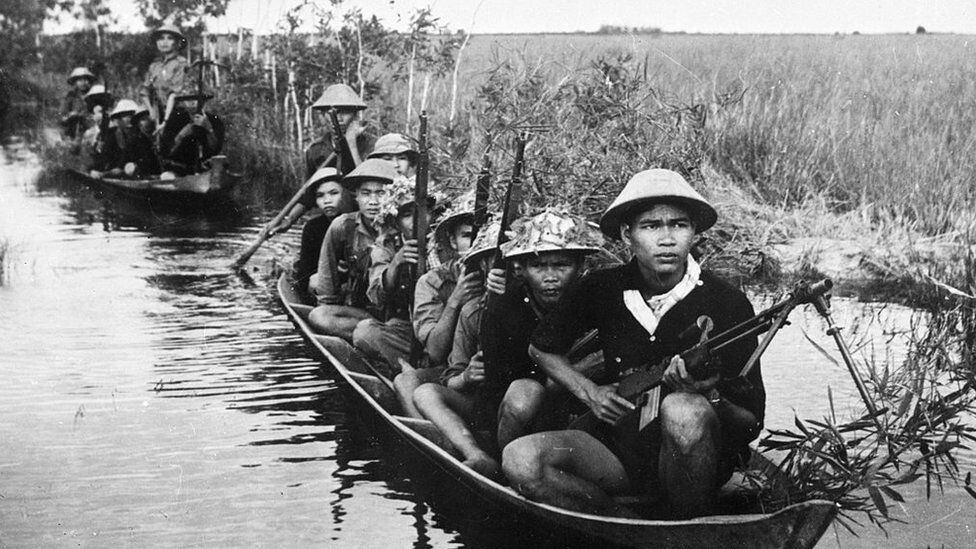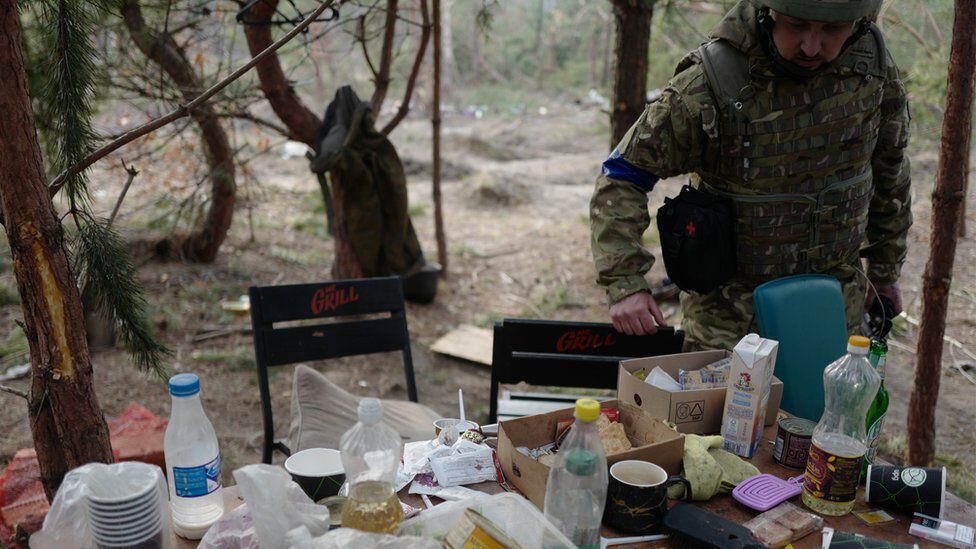In early March, images of Russian troops shooting a man with his hands up on a road outside of Kyiv they were shared around the world. Now the Russians have been pushed out of the area and the BBC’s Jeremy Bowen saw the grim consequences of their short-lived occupation.
This chronicle contains material that may be disturbing.
We counted 13 bodies on a gruesome stretch of road no more than 200 meters long, between Mria and Myla, towns whose Ukrainian names translate as Dream and Honey.
Two of the dead were confirmed to be Ukrainian civilians killed by the Russians. The others have not yet been identified. They lie where they were killed, but only two are wearing recognizable Ukrainian military uniforms.
Our BBC team was able to reach the area, on the E-40 main road near kyiv, after Ukrainian forces captured the sector just 10 hours earlier.
The marks of battle and heavy shelling were everywhere. Gas stations and a hotel known for its spa and restaurant were in shambles. Shell holes and craters marked both streets.
Ukrainian soldiers changing a tire in the ruins of a roadside garage said the Russians were about 4 km away and had withdrawn their men after heavy fighting, lasting several days, in the early hours. in the morning.
Gone are the corpses in the heart of desolation, and many questions and concerns about who they were and how they died.
There are already some answers for a couple killed by the Russians whose bodies were exposed on March 7. His rusty, shrapnel-riddled car lies on the road next to one of the gas stations, destroyed by fire.
Next to the car are the burned and twisted remains of a body that is almost recognizable as that of a man. A wedding ring is still on the corpse’s finger. Inside the car is what remains of a woman’s cremated body, her mouth open in what appears to be a scream.
Their deaths were filmed by a Ukrainian drone on March 7, operated by the Bugatti Territorial Defense unit. The unit published the video, which was republished by media outlets around the world.
It caused outrage because it showed the cold-blooded death of a man who had raised his arms to show he was harmless, with the classic gesture of surrender.
The bodies are of Maksim Iowenko and his wife Ksjena. They were part of a 10-vehicle convoy of civilians trying to escape the Russians and reach kyiv.
As they drove down the road, they saw a Russian tank in position, dug in on the edge of the grass. Video from the drone shows that it was clearly marked with the letter V, one of the identifiers used by the Russian armed forces.
The other cars quickly turned around and sped away. But Maksim’s car stopped, most likely because he was hit.
As soon as the car stopped, Maksim jumped up and raised his hands. Within seconds he was shot to death. His wife died in the car. Also traveling in the car were his six-year-old son and the elderly mother of one of Maksim’s friends. Both survived and were eventually freed by Russian soldiers.
They were found walking back down the road, and the woman told her family that Maksim was screaming that there was a child in the car when he was killed. Both, according to Bugatti’s drone unit, they are now safe but deeply traumatized.
Warning: explicit images
The car is now burned, but it was not on fire after the attack. One hypothesis is that the bodies and the car were set on fire by the Russians to destroy evidence of what they had done.
The Bugatti Unit submitted its drone video to the Ukrainian authorities and the London Metropolitan Police.
More burned cars and corpses line the road for the next few hundred meters. No video has surfaced showing what happened.
A credible guess is that the other people were killed by the Russian tank or other Russian soldiers.


There were attempts to destroy the other bodies. Some decomposed where they were killed. But other bodies have been piled up and surrounded by tires.
The charred clothing indicates that around him there were attempts to set fire. The tires are flammable and must have been placed there as an accelerator.
The emplacement where the tank was barricaded has a clear arc of fire in the area where the 13 bodies lie. The tank is gone, but its crew left behind debris, including Russian army field rations.
In the nearby forest there is at least one other tank, which caught fire after being hit by an anti-tank missile.
A Ukrainian soldier took out a wallet that he had found in the tank. He emptied Russian identity documents and Russian and Belarusian currency.
The main thrust to the northwest of kyiv came from the invaders who had crossed the border from Belarus, Moscow’s ally.
Near the destroyed tank are the remains of a chaotic camp, complete with bunkers, chairs, and a long table littered with leftover food and drink.
The remains are surrounded by large piles of garbage, rotten food and empty bottles of alcohol. Ukrainian soldiers said gas station shops were looted.

Next to the table is a large pair of shears. Piles of unburied rubbish strewn out front are often a sign of undisciplined soldiers.
We decided to drive two or three kilometers further, after the Ukrainian soldiers said that more Russian armored vehicles had been destroyed.
In a small town, a Russian tank and two armored personnel carriers were destroyed and burned. Some of the remains still smoked.
The force of the gun that destroyed the tank blew off the turret and main gun, which lay upside down and half-buried in a crater some 13 meters away.
In the pine forests on both sides of the road, Ukrainian soldiers were digging trenches with shovels. Others were patrolling. It was too early to tell if the Russians were gone forever or would return.
What is clear, however, is that Russian forces, under continued pressure from Ukrainian soldiers, have been forced to cede strategic territory around kyiv. As they recede, the Ukrainian capital and its people are a little safer.
As the Russians leave, more evidence of civilian deaths is likely to emerge, supporting the many stories that have emerged of such incidents.
The gruesome scenes on the road they are also the scene of the crime, with evidence to be collected and preserved for an investigation when this war is over.
Under the laws of war, civilians are protected and when they are killed in defiance of those laws, their deaths amount to war crimes.
Source: Elcomercio

:quality(75)/cloudfront-us-east-1.images.arcpublishing.com/elcomercio/GE3TANRNGA2C2MBSKQYDAORRG4.jpg)





